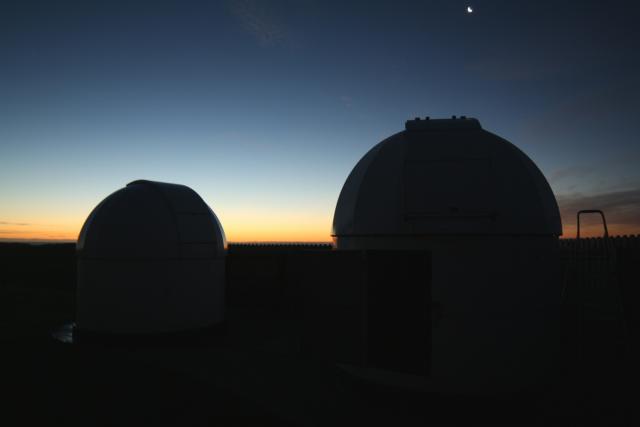› Forums › General Discussion › How was 2014 for you?
- This topic has 4 replies, 5 voices, and was last updated 10 years, 11 months ago by
 Nick James.
Nick James.
-
AuthorPosts
-
1 January 2015 at 9:13 am #573404
 Jeremy ShearsParticipant
Jeremy ShearsParticipantAs has become the custom, I am sharing my 2014 observing stats. I was able to observe from home in Cheshire on a total of 123 nights, or 34% of all nights, making it just above an average year (the 10-year average 2005-14 was 119 nights, range 94-149). I class a usable night when I am able to carry out any CCD imaging: it could be a few fields/frames or it could be many hours. The best months were March & July with 14 nights. The lowest month was May (6 nights). I should add that inevitably there were some clear nights that I missed due to other commitments, so the totals are underestimates.
So how was 2014 for you?
Happy New Year and Clear Skies for 2015!
Jeremy
Attachments:
1 January 2015 at 12:09 pm #576730 Gary PoynerParticipantHi Jeremy,Here are my Birmingham stats. Last years numbers in brackets!Observable nights (not counting brief gaps) = 112 (93)37 (59) clear and 75 (34) partially clear (50% cloud or more). Of these 112 nights 53 had Moonlight interference.Best month – Feb & July with 13 nights each (April with 12 nights)Worst month – September with 6 nights (January with 3 nights)Number of hours spent at eyepiece = 247.27 hours (191.18 hours)The weather forecast (for Birmingham) for cloudy/clear nights was incorrect on 53 (60) occasions, so a slight improvement for the Met. office!The sky conditions continue to deteriorate here in Birmingham, with increased light pollution and the clarity of the sky worsening year after year – for reasons which I can’t explain. The Milky Way was ‘glimpsed’ on just one occasion in 2014 – Aug 4th.Look forward to seeing other members stats for 2014.Happy New Year!Gary1 January 2015 at 3:29 pm #576731
Gary PoynerParticipantHi Jeremy,Here are my Birmingham stats. Last years numbers in brackets!Observable nights (not counting brief gaps) = 112 (93)37 (59) clear and 75 (34) partially clear (50% cloud or more). Of these 112 nights 53 had Moonlight interference.Best month – Feb & July with 13 nights each (April with 12 nights)Worst month – September with 6 nights (January with 3 nights)Number of hours spent at eyepiece = 247.27 hours (191.18 hours)The weather forecast (for Birmingham) for cloudy/clear nights was incorrect on 53 (60) occasions, so a slight improvement for the Met. office!The sky conditions continue to deteriorate here in Birmingham, with increased light pollution and the clarity of the sky worsening year after year – for reasons which I can’t explain. The Milky Way was ‘glimpsed’ on just one occasion in 2014 – Aug 4th.Look forward to seeing other members stats for 2014.Happy New Year!Gary1 January 2015 at 3:29 pm #576731M C Butcher
ParticipantFor 2014 I was able to image on a total of only 10 ocasions (5 day and 5 night). This is well down on previous years. The most common reasons for not imaging were, as usual, too cloudy or too windy. As it is frequently very windy it is safer not to have a permanent set up and therefore gaps in the cloud must be long enough to set up my telescope in order to achieve imaging. This temporary arrangement does not provide a steady platform to image in winds over about 10 mph, even on the leeward side of my house. However, here light pollution is not a major problem.
Martin Butcher
Inner Hebrides
3 January 2015 at 5:31 pm #576734 Denis BuczynskiParticipant
Denis BuczynskiParticipant
My observing stats at Tarbatness Observatory MPC Code I81 in Highland Scotland for 2014 are as follows:
JAN5 FEB17 MAR12 APR12 MAY4 JUN0 JUL0 AUG13 SEPT7 OCT 9 NOV13 DEC 10 total 94 nights = 1 night in 4 (1 in 3 nights if the summer 3 months are excluded)
These are defined as nights when I undertook CCD images for Comets or VS or TOCP confirmations . The summer months at 58d N lat are unusable due to all night twillight when observing is halted in MAY, June and July. These stats do not include nights when aurora and NLC observations were made. Rainfall here for the year was 855mm, this was slightly higher than the 18 year average of 796mm, so a bit wetter this year and substantially wetter than last year at 673mm.
3 January 2015 at 7:47 pm #576735 Nick JamesParticipant
Nick JamesParticipantDenis,
One in three nights, excluding the summer, is pretty good. Who was it who said “You’ll not see anything from there” when you moved up to NE Scotland?
I’ve had a look at my observing stats from Chelmsford but they are rather meaningless since I’m often not able to observe even if the weather is clear. Anyway, I obtained CCD images from Chelmsford on 107 nights in 2014 so rather worse than your one in three. I suspect it would be better if I was a gentleman of leisure…
Nick.
-
AuthorPosts
- You must be logged in to reply to this topic.
